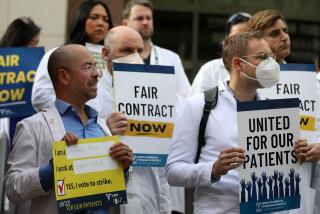Monterey County hospital group to award more large retirement packages
- Share via
A Monterey County hospital district, which came under fire last year for giving its chief executive one of the largest public pensions in California history, announced this week that several other top officials are receiving generous retirement packages.
The Salinas Valley Memorial Healthcare System awarded former executive Samuel Downing retirement and severance payments totaling nearly $5 million along with a pension of more than $100,000 a year.
Now, in response to public records requests made by The Times and others, the hospital has acknowledged that at least four other outgoing administrators will receive lucrative benefits as well.
The hospital’s chief operating officer is to receive a supplemental retirement payment of $1.3 million on top of an annual pension of about $97,000, according to estimates released by the district. Its chief financial officer will collect a supplemental retirement payment of $1 million plus an annual pension of $108,000.
The executives’ retirement benefits come despite recent financial struggles at the Salinas Valley hospital, which is a public entity overseen by an elected board. Hundreds of staff positions at the hospital have been eliminated since the start of 2010.
The disclosure of the large retirement packages is expected to add to an already heated debate over public pensions. On Tuesday, Assemblyman Luis Alejo (D-Watsonville) said he would write a bill that would prohibit public hospitals from awarding multiple pensions to employees.
Gov. Jerry Brown introduced a 12-point plan to overhaul government employee pensions late last year, drawing opposition from labor unions. A competing initiative is being pushed by California Pension Reform, a group led by former state officials who say Brown’s plan doesn’t go far enough.
Daniel Pellissier, the group’s president, said the Salinas hospital executives’ pensions were “glaring evidence of government employees using taxpayer money to enrich themselves.”
“It almost seems like a gift of public funds,” Pellissier said.
But officials at the Salinas Valley hospital in the past have staunchly defended the retirement benefits. On Tuesday, Adrienne Laurent, a spokeswoman for the hospital, said the supplemental pensions were part of the strategy the hospital’s board used to retain highly qualified executives.
“It’s a basic rule of talent retention,” she said. “The board wanted to be competitive, and salary and benefits are a big part of that.”
Laurent added that although the hospital discontinued the supplemental retirement plan at the end of last year, it still plans to pay the money promised previously to administrators. “Our board does not go back on its word,” she said.
The board members did not respond to interview requests, and interim chief executive Lowell Johnson declined to comment.
Last year, a hospital consultant said in an interview with The Times that the pensions were designed to “take advantage” of IRS limits on deferred compensation by spreading retirement money across several accounts. The consultant, who no longer works for the hospital, said the setup was legal and not uncommon.
But Marcia Fritz, another pension reform advocate, said that the hospital’s retirement plan showed a flaw in the IRS code.
“The IRS needs to tighten the rules on these abusive tax shelters,” she said. “I don’t see why the same controls that are applied to the private sector aren’t applied to these employees. What makes them so special?”
John Borsos, a vice president for the National Union of Healthcare Workers, which represents many of the hospital’s employees, said the latest pension figures were another sign that the hospital’s board had lost touch with the needs of residents who rely on the hospital for medical care.
“It’s just an outrage, that the hospital is willing to take caregivers away from the bedside while providing these types of benefits for its administration,” he said.
In addition to Chief Operating Officer Bev Ranzenberger and Chief Financial Officer John Fletcher, two other administrators who participated in the executive retirement plan will walk away with generous packages.
Chief Medical Officer David Perrott, who worked at the hospital for 11 years, will receive a supplemental retirement payment of more than $370,000, along with an annual pension of about $50,000, according to the hospital’s estimates. Liz Lorenzi, a vice president of business development, will receive a supplemental payment of $357,000 and an annual pension of $54,000.
All four of the administrators were paid salaries of about $340,000 a year, the hospital said. Downing, the former chief executive, made a salary of about $660,000.
In interviews last year, Downing said he felt he deserved his compensation after nearly four decades of service and praised the board members’ decision-making.
“The board did an excellent job,” he said. “They made sure we had competitive salaries.”
More to Read
Sign up for Essential California
The most important California stories and recommendations in your inbox every morning.
You may occasionally receive promotional content from the Los Angeles Times.










